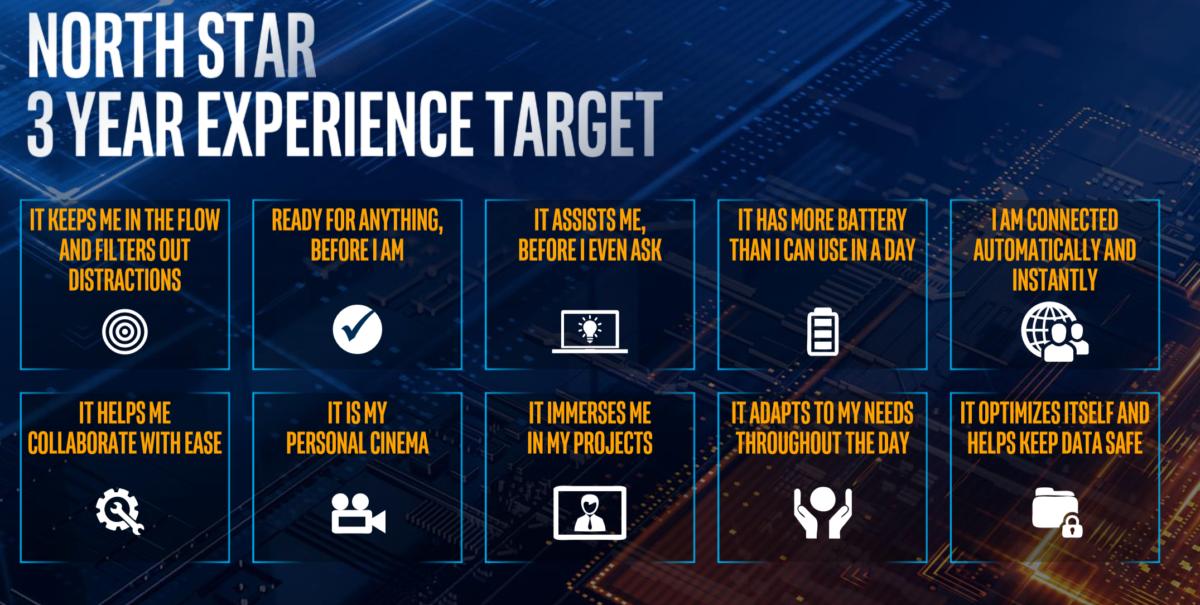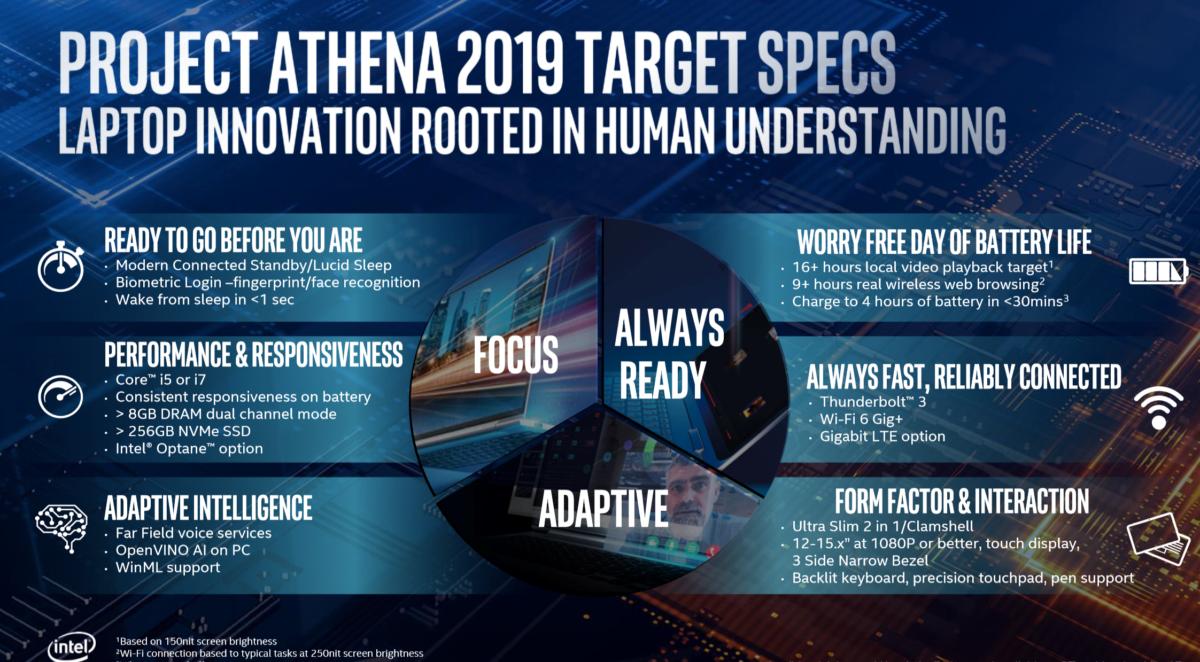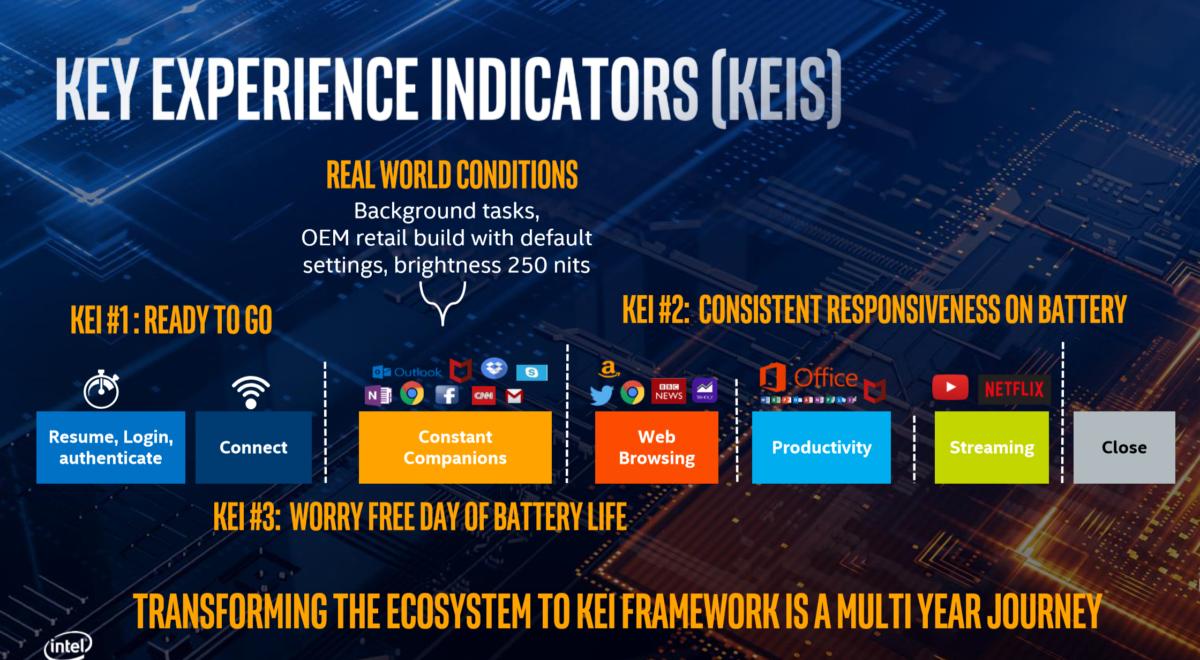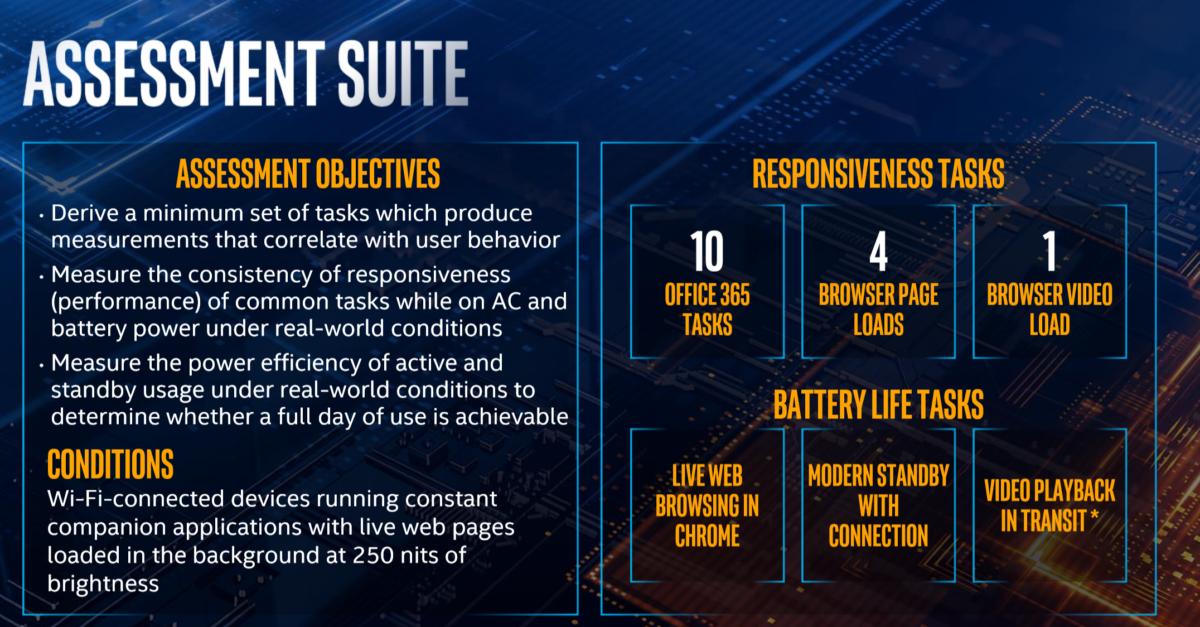After unveiling its grand vision for the future of mobile computing at CES in January, Intel finally provided more detail on what exactly will be inside the "Project Athena" notebooks that will begin shipping later this year, showcasing how the company thinks the laptop market should evolve.
Intel sees the "Project Athena" notebooks as essentially the next generation of ultrabooks, but they're also a showcase for Intel's strengths. There's less emphasis, for example, on the 5G technologies that rival chipmaker Qualcomm deems essential. Though the company isn't defining exactly how an Athena notebook should be made, the company does have compliance and qualification programs in place. Most importantly, Intel has also listed requirements for specific types of components that should be included in a Project Athena laptop, such as a precision touchpad and Thunderbolt 3.
Failure to pass Intel's verification tests means that the hardware partner won't be allowed into Intel's marketing programs, a cost-sharing program that can assist the PC maker. This makes Intel's requirements—more of which the company began sharing just before Computex began—critical.
 Mark Hachman / IDG
Mark Hachman / IDGIntel showed off a Dell Precision laptop as part of its Project Athena initiative.
At Computex, we're expecting to see our first examples of what Project Athena notebooks will look like. While "Athena" notebooks won't be specifically labeled as such, they should be fairly obvious. The first batch of about 30 will include premium laptops, such as a new Dell Precision notebook PC that Intel executives showed off before the trade show began.
Project Athena, based on your experiences
Intel has said previously that it will work with top-tier partners including Acer, Asus, Dell, HP, Lenovo, Microsoft, Samsung, Sharp, and even Google to deliver the first Project Athena notebooks in the fall of 2019. Next year, attention turns to the smaller ODMs and "white box" vendors, who will receive assistance from Intel via the Project Athena Open Labs initiative.
You might call Project Athena notebooks as the devices for the gig economy—they're optimized for workers like realtors or writers who migrate from a shared office to a coffee shop, toggling back and forth between work and play. Though Intel is often thought of as being powered by hard data, the company has a history of anthropological research to influence its internal direction, and Intel compiled several "key experience indicators" (KEIs) to guide Athena's development.
 Intel
IntelThese are some of the guiding principles that Intel is using to define the Project Athena specifications, based upon feedback that the company has gathered from users.
Some of those guidelines wandered into focus group territory. Someone who "define[s] 'success' as finding meaning and joy in life vs. traditional norms" was what Intel used to describe one target customer, executives said at a pre-Computex briefing. Still, Josh Newman, vice president of the Client Computing Group at Intel, said that Project Athena has made the PC's role quite fundamental. In the age of distractions, he said, the PC is the device where you turn to to focus.
What's inside a Project Athena notebook
This is what we know of the Project Athena specs so far. Though Intel didn't explicitly specify this, we can probably assume that these are minimum specifications.
- Display: 12 in. to 15 in., 1080p or better, touch; Intel is also defining a "three-side narrow bezel"
- Processor: Core i5 or Core i7
- Memory: 8GB dual-channel DRAM
- Storage: 256GB NVMe SSD; Intel Optane (optional)
- I/O: Thunderbolt 3; Wi-Fi 6 Gig+; Gigabit LTE (optional)
- User interface: backlit keyboard; Precision touchpad; pen support
- AI: far-field mics and voice services; WinML support; OpenVINO AI
- Other features: Modern Connected Standby/ Lucid Sleep; biometric login (fingerprint or face); wake from sleep in less than a second
- Battery: 16+ hours of local video playback at 150 nits; 9+ "real wireless Web browsing" at 250 nits; Charge to 4 hours of battery in less than 30 minutes
- Dimensions: "Ultra slim 2-in-1/Clamshell"; possibly less than three pounds
We don't know every one of the actual Project Athena requirements. But according to Intel, there will be at least 23, of which 14 will be self-certified by the manufacturer itself. Intel will perform its own verifications at the Athena Labs facilities, including performance checks and power checks that are critical to the Athena experience.
 Intel
IntelThe assessment suite doesn't test the speed of the device. Instead, it verifies the responsiveness—how fast it loads apps, resumes from a sleep state, and so on. The assessment objectives are designed to correlate with human behavior, measuring how quickly Microsoft's Office 365 apps load, for example, or how quickly a browser loads. There will also be a 30-minute quick-charge test as well as a test of the Intel Smart Sound Technology.
"So with these assessments, we're going to go and manually verify devices from customers that are going to send us a number of units," said Majeen Salman, an engineering manager for Intel. "They're going to sit in our labs, we're going to measure them, we're going to give feedback to that customer. And then when when they feel ready, we're going to go through a final verification process and certify that they are compliant with the specification."
Ditching benchmarks for real-world tests
What's different about the Project Athena tests is that they use real-world conditions to determine, for example, whether a laptop can achieve a full day's battery life. Those conditions, for example, may include live webpages being loaded while companion apps run. "So the same set of engineers that has spent time tuning and optimizing the platforms historically against synthetic benchmarks, will now spend time focused on the Athena benchmarks and Athena metrics and the [key experience indicators] instead of those measurements," Salman said.
 Intel
IntelHere's how some of what users like you experience in the real world translate into the Project Athena testing metrics.
It's an enormous change to how benchmark testing is usually performed, based upon repeatable benchmarks run under carefully controlled conditions. Sudha Ganesh, Intel's senior director in charge of Systems and Solutions Assessments, told reporters that she asks her staff to run the same benchmarks as many as 30 times successively, so as to ensure results that will vary, but overlap enough to generate a high degree of statistical confidence in the outcome.
"I'm not looking for the 10th decimal digit accuracy [on a benchmark], but to deliver [a result] so that I know what to expect from my laptop all the time," Ganesh said.
 Intel
IntelWhat does all this mean? Well, we know a little more about what "Project Athena" notebooks will have under the hood when they begin to ship later this year. But, more importantly, we know that Intel didn't design them to a set of numbers, but to something approximating the same set of experiences that we face in the real world. Does that mean Athena notebooks will be better? We can't say that for sure. But it sounds like what we experience as users and what PC makers are designing for will be more in line than they have historically been.
Editor's note: This article originally published on May 28, 2019, but was updated to add the video showing some Project Athena laptops.
Không có nhận xét nào:
Đăng nhận xét